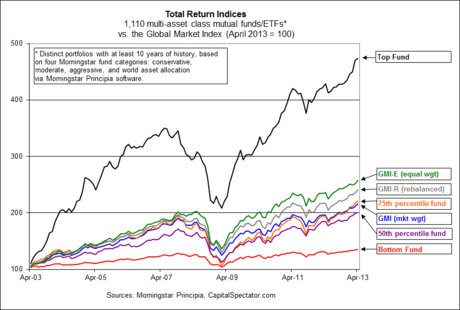Meb Faber reminds us that a buy-and-hold strategy is the first cousin to market-cap weighting. In fact, if you wait long enough, the two become virtually identical sans intervention. The problem, of course, as Faber notes, is that buy-and-hold/cap-weighting increasingly favors overvalued assets and, by implication, underweights assets that are trading at relatively inexpensive valuations, which presumably are linked with superior expected returns. “That, to me, is the biggest failing of buy and hold,” he writes. “It ignores common sense.”
I tend to agree, but it’s dangerous to leave that statement to fend for itself without elaboration. This is finance, after all, and so even prudent recommendations in this house of mirrors may come with unintended surprises at times. For instance, recognizing that buy-and-hold/cap-weighting ends up dispensing concentration risk via the hottest assets isn’t the same thing as saying that it’s easy to beat this mother of all passive strategies through time. Volumes have been written on this point and so I won’t elaborate other than to point to one piece of the empirical record that shows up semi-regularly on these pages: a comparison of a market-value-weighted mix of all the major asset classes vs. 1,000-plus actively managed mutual funds with at least 10 years of history that practice some form of multi-asset class investing. In a recent update (May 2013) I pointed out that a passive mix of broadly defined asset classes (the Global Market Index) once again delivered above-average performance (the 70th percentile, to be precise) relative to a broad sample of active strategies for the trailing decade. If you overlay a naïve end-of-the-year rebalancing regimen on GMI’s mix, you did a bit better. Here’s the chart:

I’ve been crunching these numbers regularly for several years (although I don’t publish every update) and the general result is usually about the same. GMI dispenses competitive and sometimes impressively competitive results vs. the crowd. (I’ll have an update on this profile soon, by the way). There are some fundamental reasons for why this is so, and for expecting comparable results in the years ahead. It boils down to what Professor Bill Sharpe labeled the Arithmetic of Active Management: “Properly measured, the average actively managed dollar must underperform the average passively managed dollar, net of costs.” Does this mean you should buy and hold everything and leave it alone? No, probably not, although you could do a lot worse.
Yes, it’s important to recognize that buy-and-hold/market-cap weighting excels in bringing you a specific basket of risk factors. What’s more, those risk factors may not be optimal, particularly for your specific circumstances. But it’s naïve to think that simply minimizing or avoiding this particular group of risk factors will bring fame and fortune with minimal effort.
The problem is that if you decide to sidestep buy-and-hold/market-cap weighting, you must choose something else, i.e., a different set of risk factors. Now the fun begins. Which set of risk factors and why? How should you weight an alternative set of risk factors? How and when should you rebalance? Is this set of risk factors really timely now? What’s the rationale for the strategy you choose? Does it have a real-world record of success for any length of time, i.e., through at least one full business cycle? (And, no, back-testing on paper doesn’t count, although it’s useful as a research tool.) Abandoning buy-and-hold/market-cap weighting has a number of advantages, at least in theory, but brevity and simplicity aren’t on that list. Depending on how you choose to second-guess Mr. Market’s portfolio, low-cost investing may be a victim too.
It’s easy to see how so many investors have a hard time keeping up with Mr. Market’s results. If you make the wrong choices on one or more of the questions above (which only scratch the surface of issues that arise in active management), how much does that hurt your results? The dirty little secret of active management is that it only works if you make a series of correct choices in real time–for years, if that’s your investment horizon. Sure, you can be wrong sometimes and still do well. Mr. Market certainly makes mistakes. He may be making a big one right now, as Faber suggests. But recognizing that Mr. Market is wrong from time to time (most of the time?) is only half the battle–you also have to be right more than occasionally.
The main question is deciding if you’ll do better with a risk profile that’s conspicuously different than buy-and-hold/market cap? Yes, of course, you can… maybe. There are some persuasive arguments for why you should build a portfolio that’s distinguishes itself as being something other than Mr. Market’s asset allocation, but assuming that you’re smarter than everyone else isn’t one of them.
In any case, trading one rather well-known, modestly successful risk profile for something else that may be less transparent shouldn’t be taken lightly. In other words, it’s essential that you understand why and how your customized strategy differs from Mr. Market’s naïve mix and why it’s expected to deliver better results.
The basic dynamic here is that in order to deliver superior risk-adjusted results vs. GMI or its equivalent you need to take relatively larger or smaller risk bets. There’s an endless line of possibilities, starting with choosing different asset weights and adding a rebalancing strategy. What you won’t find, however, is an endless line of success in evaluating history on this front. Mr. Market’s asset allocation may be foolish, unimaginative, and seemingly destined for mediocrity or worse on an ex ante basis. But ex post it tends to look pretty decent vs. a broad spectrum of strategies that, on paper, should have performed a lot better but didn’t.
Perhaps common sense isn’t always what it seems to be in the money game.